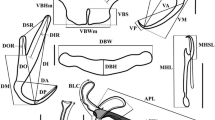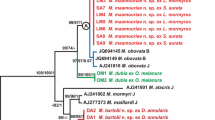Abstract
Phyllodistomum inecoli n. sp. is described from the twospot livebearer, Heterandria bimaculata (Teleostei: Poeciliidae), collected in the Río La Antigua basin, Veracruz, Mexico. The new species is described and characterised by using a combination of morphology, scanning electron microscopy, and sequences of nuclear and mitochondrial genes. Diagnostic characters of the new species of Phyllodistomum include a genital pore opening at the level of the caecal bifurcation; oval vitellarium, situated just posterior to the ventral sucker and not extended laterally and anterior extracaecal uterine loops variable in extension (reaching the anterior, median or posterior margin of the ventral sucker). P. inecoli n. sp. most closely resembles P. brevicecum, a species described as a parasite of the central mudminnow, Umbra limi, in other parts of North America; however, the genital pore in P. brevicecum is situated between the caecal bifurcation and the ventral sucker, the ovary is larger, the vitellarium is lobed and extended laterally and the anterior portion of the uterus extends to the posterior margin of the ventral sucker. Comparison of about 1,500–2,200 nucleotides of cox1 and 28S rDNA and ITS1 strongly supports the status of P. inecoli as a new species. Bayesian inference analysis of combined datasets of 28S rDNA and cox1 sequences showed that P. inecoli n. sp. and the other species found in freshwater fishes of Mexico, including the species complex of P. lacustri, are not sister species. Phylogenetic analysis based on 28S rDNA sequences of several gorgoderid taxa revealed the close relationship of P. inecoli n. sp. with several species of Phyllodistomum, Gorgodera and Gorgoderina with cystocercous cercariae developing in sphaeriid bivalves. Dot-plot analysis of ITS1 sequences of P. inecoli n. sp. revealed the presence of eight repetitive elements with different length, which together represent almost half the length of ITS1.






Similar content being viewed by others
References
Bakke TA (1985) Phyllodistomum conostomum (Olsson, 1876) (Digenea, Gorgoderidae): a junior subjective synonym for P. umblae (Fabricius, 1780). Zool Scripta 14:161–168
Bakke TA, Ždárská Z (1985) Tegumental microtopography and arrangement of papillae in adult Phyllodistomum folium (Olfers, 1816) (Digenea: Gorgoderidae) from pikes (Esox lucius L.). Folia Parasitol 32:43–49
Bowles J, Blair D, McManus DP (1995) A molecular phylogeny of the human schistosomes. Mol Phylogenet Evol 4:103–109
Bravo-Hollis M, Manter HW (1957) Trematodes of marine fishes of Mexican waters: X. Thirteen Digenea, including nine new species and two new genera, from the Pacific coast. Proc Helminthol Soc Wash 24:35–48
Campbell RA (2008) Family Gorgoderidae Looss, 1899. In: Bray RA, Gibson DI, Jones A (eds) Keys to the Trematoda, 3rd edn. CAB International, Wallingford, pp 191–214
Cribb TH (1987) A new species of Phyllodistomum (Digenea: Gorgoderidae) from Australian and New Zealand freshwater fishes with notes on the taxonomy of Phyllodistomum Braun, 1899. J Nat Hist 21:1525–1538
Cribb TH, Chisholm LA, Bray RA (2002) Diversity in the Monogenea and Digenea: does lifestyle matter? Int J Parasitol 32:321–328
Curran SS, Tkach VV, Overstreet RM (2011) Phylogenetic affinities of Auriculostoma (Digenea: Allocreadiidae), with description of two new species from Peru. J Parasitol 97:661–670
Curran SS, Tkach VV, Overstreet RM (2013) A new species of Homalometron (Digenea: Apocreadiidae) from fishes in the northern Gulf of Mexico. J Parasitol 99:93–101
Cutmore SC, Miller TL, Curran SS, Bennett MB, Cribb TH (2013) Phylogenetic relationships of the Gorgoderidae (Platyhelminthes: Trematoda), including the proposal of a new subfamily (Degeneriinae n. subfam.). Parasitol Res. doi:10.1007/s00436-013-3481-5
Darriba D, Taboada GL, Doallo R, Posada D (2012) jModelTest 2: more models, new heuristics and parallel computing. Nat Methods 9:772
Dvořák J, Vaňáčová Š, Hampl V, Flegr J, Horák P (2002) Comparison of European Trichobilharzia species on ITS1 and ITS2 sequences. Parasitology 124:307–313
Edgar RC (2004) MUSCLE: multiple sequence alignment with high accuracy and high throughput. Nucl Acids Res 32:1792–1797
Galtier N, Gouy M, Gautier C (1996) SEAVIEW and PHYLO_WIN: two graphic tools for sequence alignment and molecular phylogeny. Comput Appl Biosci 12:543–548
Gibbs AJ, McIntyre GA (1970) The diagram, a method for comparing sequences. Its use with amino acid and nucleotide sequences. Eur J Biochem 16:1–11
Guindon S, Gascuel O (2003) A simple, fast and accurate method to estimate large phylogenies by maximum-likelihood. Syst Biol 52:696–704
Hall TA (1999) BioEdit: a user-friendly biological sequence alignment editor and analysis program for Windows 95/98/NT. Nucl Acid Symp Ser 41:95–98
Helt J, Janovy J Jr, Ubelaker J (2003) Phyllodistomum funduli n. sp. (Trematoda: Gorgoderidae) from Fundulus sciadicus Cope from Cedar Creek in western Nebraska. J Parasitol 89:346–350
Hoffman GL (1999) Parasites of North American freshwater fishes, 2nd edn. Cornell University Press, Ithaca
Hrbek T, Seckinger J, Meyer A (2007) A phylogenetic and biogeography perspective on the evolution of poeciliid fishes. Mol Phylogenet Evol 43:986–998
Kohn A, Fernandes BMM, Cohen SC (2007) South American trematodes parasites of fishes. Ministerio da Saúde, FIOCRUZ, Rio de Janeiro
Lamothe-Argumedo R, García-Prieto L, Osorio-Sarabia D, Pérez-Ponce de León G (1997) Catálogo de la Colección Nacional de Helmintos. UNAM-CONABIO, México
Lucinda PHF, Reis RE (2005) Systematics of the subfamily Poeciliinae Bonaparte (Cyprinodontiformes: Poeciliidae), with an emphasis on the tribe Cnesterodontini Hubbs. Neotrop Ichthyol 3:1–60
Lynch JE (1936) Phyllodistomum singulare n. sp., a trematode from the urinary bladder of Dicamptodon ensatus (Eschscholtz), with notes on related species. J Parasitol 1:42–47
Mendoza-Garfias B, Pérez-Ponce de León G (2005) Phyllodistomum centropomi sp. n. (Digenea: Gorgoderidae), a parasite of the snook, Centropomus parallelus (Osteichthyes: Centropomidae), in the Papaloapan River at Tlacotalpan, Veracruz State, Mexico. Zootaxa, 1056:42–51
Miller RR, Mincley WL, Norris SM (2005) Freshwater fishes of México. University of Chicago Press, Chicago
Parker JH, Curran SS, Overstreet RM, Tkach VV (2010) Examination of Homalometron elongatum Manter, 1947 and description of a new congener from Eucinostomus currani Zahuranec, 1980 in the Pacific Ocean off Costa Rica. Comp Parasitol 77:154–163
Pérez-Ponce de León G, Choudhury A (2002) Adult endohelminth parasites of ictalurid fishes (Osteichthyes: Ictaluridae) in Mexico: empirical evidence for biogeographical patterns. Comp Parasitol 69:10–19
Pérez-Ponce de León G, Choudhury A (2010) Parasite inventories and DNA-based taxonomy: lessons from helminths of freshwater fishes in a megadiverse country. J Parasitol 96:236–244
Pérez-Ponce de León G, García-Prieto L, Mendoza-Garfias B (2007) Trematode parasites (Platyhelminthes) of wildlife vertebrates in Mexico. Zootaxa 1534:1–247
Pulis EE, Fayton TJ, Curran SS, Overstreet RM (2013) A new species of Intromugil (Digenea: Haploporidae) and redescription of Intromugil mugilicolus. J Parasitol 99:501–508
Razo-Mendivil U, Pérez-Ponce de León G (2011) Testing the evolutionary and biogeographical history of Glypthelmins (Digenea: Plagiorchiida), a parasite of anurans, through a simultaneous analysis of molecular and morphological data. Mol Phylogenet Evol 59:341–351
Razo-Mendivil U, Vázquez-Domínguez E, Rosas-Valdez R, Pérez-Ponce de León G, Nadler SA (2010) Phylogenetic analysis of nuclear and mitochondrial DNA reveals a complex of cryptic species in Crassicutis cichlasomae (Digenea: Apocreadiidae), a parasite of Middle-American cichlids. Int J Parasitol 70:471–486
Ronquist F, Teslenko M, van der Mark P, Ayres D, Darling A, Höhna S, Larget B, Liu L, Suchard MA, Huelsenbeck JP (2012) MrBayes 3.2: efficient Bayesian phylogenetic inference and model choice across a large model space. Syst Biol 61:539–542
Rosas-Valdez R, Pérez-Ponce de León G (2008) Composición taxonómica de los helmintos de ictalúridos y heptaptéridos (Osteichthyes: Siluriformes) de México, con una hipótesis de homología biogeográfica primaria. Rev Mex Biod 79:473–499
Rosas-Valdez R, Choudhury A, Pérez-Ponce de León G (2011) Molecular prospecting for cryptic species in Phyllodistomum lacustri (Platyhelminthes, Gorgoderidae). Zool Scr 40:296–305
Rosen DE, Bailey RM (1963) The poeciliid fishes (Cyprinodontiformes), their structure, zoogeography, and systematics. Bull Am Mus Nat Hist 126:1–176
Rubio-Godoy M, Paladini G, García-Vásquez A, Shinn AP (2010) Gyrodactylus jarocho sp. nov. and G. xalapensis sp. nov. (Platyhelminthes: Monogenea) from Mexican poeciliids (Teleostei: Cyprinodontiformes), with comments on the known gyrodactylid fauna infecting poeciliid fish. Zootaxa 2509:1–29
Salgado-Maldonado G (2006) Checklist of helminth parasites of freshwater fishes from Mexico. Zootaxa 1324:1–357
Schlick-Steiner BC, Steiner FM, Seifert B, Stauffer C, Christian E, Crozier RH (2010) Integrative taxonomy: a multisource approach to exploring biodiversity. Annu Rev Entomol 55:421–438
Schwarz G (1978) Estimating the dimension of a model. Ann Stat 6:461–464
Snyder SD, Tkach VV (2011) Aptorchis kuchlingi n. sp. (Digenea: Plagiorchioidea) from the Oblong Turtle, Chelodina oblonga (Pleurodira: Chelidae), in Western Australia. Comp Parasitol 78:280–285
Steen EB (1938) Two new species of Phyllodistomum (Trematoda: Gorgoderidae) from Indiana fishes. Am Midl Nat 1:201–210
Swofford DL (2003) PAUP*. Phylogenetic analysis using parsimony (*and other methods), version 4.0b10. Sinauer Associates, Sunderland
Tkach VV, Curran SS, Bell JA, Overstreet RM (2013) A new species of Crepidostomum (Digenea: Allocreadiidae) from Hiodon tergisus in Mississippi, and molecular comparison with three congeners. J Parasitol. doi:10.1645/13-279.1
van Herwerden L, Blair D, Agatsuma T (1998) Intra- and inter-specific variation in nuclear ribosomal internal transcribed spacer 1 of the Schistosoma japonicum species complex. Parasitology 116:311–317
van Herwerden L, Blair D, Agatsuma T (1999) Intra- and inter-specific variation in ITS1 of Paragonimus westermani (Trematoda: Digenea) and related species: implications for phylogenetic studies. Mol Phylogenet Evol 12:67–73
Vidal-Martínez VM, Aguirre-Macedo ML, Scholz T, González-Solís D, Mendoza-Franco EF (2001) Atlas of the helminth parasite of cichlid fish of México. Academia, Praha
von der Schulenburg JHG, Hancock JM, Pagnamenta A, Sloggett JJ, Majerus MEN, Hurst GDD (2001) Extreme length and length variation in the first ribosomal internal transcribed spacer of ladybird beetles (Coleoptera: Coccinellidae). Mol Biol Evol 18:648–660
Warberg R, Jensen KT, Frydenberg J (2005) Repetitive sequences in the ITS1 region of ribosomal DNA in congeneric microphallid species (Trematoda: Digenea). Parasitol Res 97:420–423
Wheeler QD (2008) The new taxonomy. CRC Press, New York
Will KW, Mishler BD, Wheeler QD (2005) The perils of DNA barcoding and the need for integrative taxonomy. Syst Biol 54:844–851
Yamaguti S (1971) Synopsis of digenetic trematodes of vertebrates. Keigaku Publishing Co, Tokyo
Acknowledgments
We are grateful to Ismael Guzmán for his help with collecting hosts. We thank Luis García, CNHE, Mexico City, for the loan of specimens. We are especially grateful to Anindo Choudhury, St. Norbert College, Wisconsin, USA, for the donation of specimens of Phyllodistomum spp. Thanks are also due to Berenit Mendoza for preparing samples for the SEM study, and Laura Márquez for her help with obtaining the sequences. We acknowledge the constructive comments to the first draft of the paper by Thomas Cribb (University of Queensland, Australia) and one anonymous reviewer. U.R.M. thanks the Instituto de Ecología, A.C. (INECOL) for providing research facilities during his postdoctoral stay and for granting his postdoctoral fellowship. This research was supported by grants from Consejo Nacional de Ciencia y Tecnología (CONACyT No. 168306) to M.R.G., and from Dirección General de Asuntos del Personal Académico (PAPIIT IN202111) to G.P.P.L.
Author information
Authors and Affiliations
Corresponding author
Electronic supplementary material
Below is the link to the electronic supplementary material.
ESM 1
(PDF 98 kb)
Fig. S1
Dot-plot analysis of ITS sequences of Phyllodistomum inecoli n. sp. Presence of repetitive elements within ITS sequences is evidenced by the number of lateral diagonals on both sides of the central diagonal (PDF 64 kb)
Rights and permissions
About this article
Cite this article
Razo-Mendivil, U., Pérez-Ponce de León, G. & Rubio-Godoy, M. Integrative taxonomy identifies a new species of Phyllodistomum (Digenea: Gorgoderidae) from the twospot livebearer, Heterandria bimaculata (Teleostei: Poeciliidae), in Central Veracruz, Mexico. Parasitol Res 112, 4137–4150 (2013). https://doi.org/10.1007/s00436-013-3605-y
Received:
Accepted:
Published:
Issue Date:
DOI: https://doi.org/10.1007/s00436-013-3605-y




